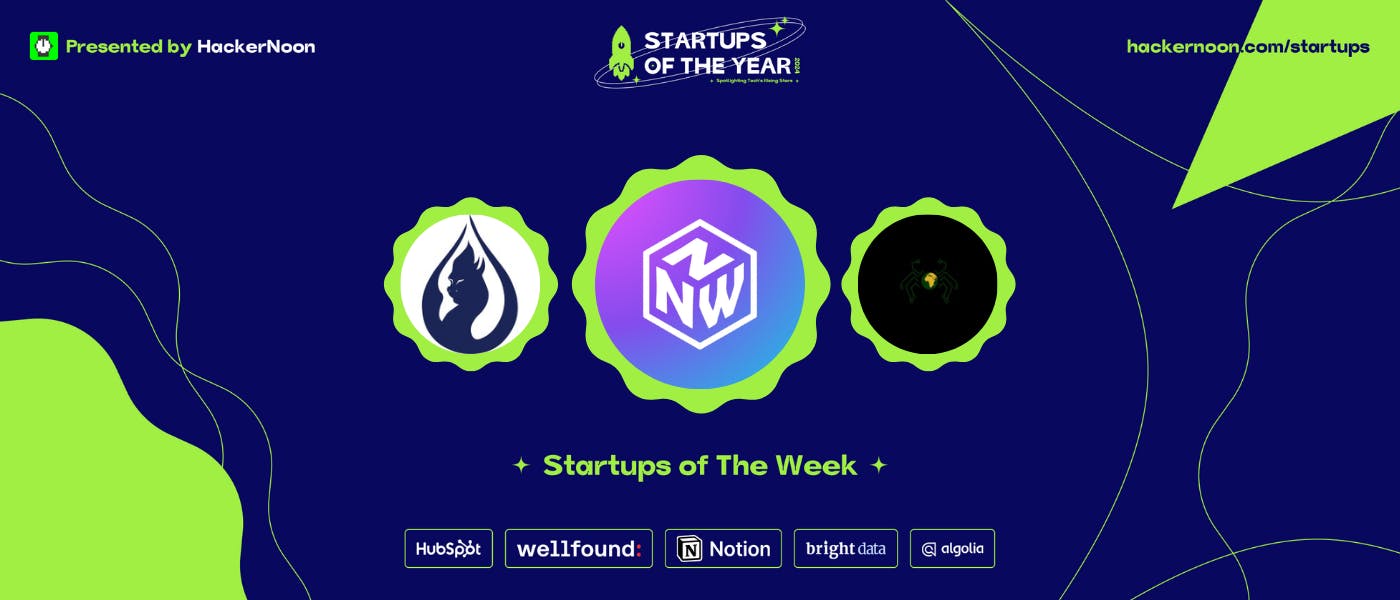Every organization needs a social media policy. It’s a critical document that sets boundaries and expectations for everyone associated with your brand.
Your brand may or may not have a major corporate social presence. But your employees and associates are absolutely using these platforms. And they may be using them to talk about you.
A clear policy protects both the brand and its employees from reputational, compliance, and security risks. Keep reading to learn more and download our free, customizable social media policy template so you can start building or updating yours right away.
Key takeaways
- Every brand needs a social media policy. It’s your playbook for staying consistent, on-brand, and out of trouble.
- Think beyond rules. A good policy also outlines roles, ownership, and security so everyone knows who’s doing what (and how to do it safely).
- Protect your brand and your people. Clear guidelines help avoid legal, compliance, and reputational messes before they happen.
- Train and update often. Social media changes fast, so keep your policy fresh and make sure your team actually understands it.
- Plan for the “what ifs”. Include crisis protocols, escalation paths, and even AI guidelines so you’re ready for anything.
In enterprise organizations — especially those in regulated industries — a social media policy is more than a set of rules for posting online. It’s a governance document that defines roles, mitigates legal and compliance risk, and protects brand reputation across multiple markets.
A social media policy is an official company document that provides guidelines and requirements for your organization’s social media use.
Your social media policy covers your brand’s official channels and how employees use social media platforms — personally and professionally.
An official company social media policy helps to maintain your brand voice and mitigate social media risks.
For marketing leaders, a social media policy isn’t just about avoiding mistakes — it’s a framework for scaling your brand presence responsibly.
In large or regulated organizations, a clear policy protects against legal exposure, reduces reputational risk, and empowers teams to engage confidently within defined guardrails. The stronger the policy, the less time leadership spends firefighting, and the more time they can spend driving growth.
Here are some of the most important reasons to implement a social media policy.
Ensure regulatory compliance
This is especially important for brands and organizations in the regulated industries. But all brands have regulatory compliance responsibilities, especially for marketing claims and disclosures.
A well-crafted and enforced social policy keeps you in line with the rules and regulations.
For example, The Candida Diet’s social media policy includes health claim guidelines. These apply even to employees’ personal accounts. The company added them after an employee’s post created regulatory concerns.
“One of the team members posted a very personal and passionate piece about our probiotics that unintentionally landed us in non-FDA-compliant territory,” says Lisa Richards, CEO of The Candida Diet. “This taught us to include a non-negotiable disclaimer, like ‘Personal opinion, not medical advice,’ on all employee wellness-related posts.”
Manage brand risk
A solid social media policy helps protect your accounts against risks. Especially when it includes details on proper security protocols. It can help prevent:
- security breaches
- reputational damage
- compliance violations and legal issues
A social policy also makes sure you have an emergency response plan in place.
For example, the cybersecurity firm Action1 has instructions in its social media to be on the alert for phishing schemes. “Especially on LinkedIn, where attackers might pretend to be recruiters,” says VP of Product Strategy Peter Barnett.
Encourage your employees to amplify your brand’s message in a brand-safe way
When you’ve got big product news or a message to share, it’s great to have your whole team on board. But that can be a delicate dance.
“With more employees acting as thought leaders or even influencers for their brands on LinkedIn, policies need to help employees navigate their online presence when representing the company they work for or are promoting,” says Trish Riswick, Hootsuite’s Social Marketing Team Lead.
Every effective policy covers certain must-have components, from defining ownership to setting clear conduct guidelines. If you’re building yours from scratch, you can follow along using our free social media policy template — it’s structured to include all of these components.
Roles and responsibilities
Define your team’s roles and responsibilities for your social accounts. Who covers which responsibilities on a daily, weekly or as-needed basis? It can be helpful to include names and contact info for key roles. That way, employees from other teams know who to contact.
Responsibilities to cover might include:
This section should establish who can speak for your brand on social media — and who can’t.
A comprehensive social media suite like Hootsuite can be very useful for solidifying your social media workflow. Your social tools can do everything automatically, so you don’t need a lengthy workflow section in your policy.
In Hootsuite, you can:
- collaborate on drafts,
- set posting permissions for individual team members,
- and set up easy approvals so the right people have final say.
This ensures you always post approved content. It also keeps the quality of your conversations with followers on brand.
Account ownership structure
Employees are becoming more visible on brand social channels. So it’s important to clarify who owns accounts and content.
Employee contracts already clarify ownership of content they create. But what about the social accounts and social groups themselves?
“When the top sales manager quit at one of our SaaS clients, he tried to take a LinkedIn group with him,” says Steve Morris, Founder & CEO, NEWMEDIA.COM.
“This is a group that was bringing in dozens of solid leads every week. Because our client had a policy with precise ownership details, logs, and a checklist for handing over account access, they had all the proof they needed. That paperwork stopped what could have been a financial disaster.”
Do you have employees managing social communities like Facebook or LinkedIn Groups? Your policy should clearly detail who owns the groups and specify how staff will transfer them when roles change.
Security protocols
As mentioned above, there are a lot of social media security risks out there. In this section of your policy, you provide guidance on identifying and dealing with them.
Topics to cover might include:
- Rules related to personal use of social media on business equipment.
- Social media activities to avoid. This includes quizzes that ask for personal or sensitive information.
- Guidelines on how to create an effective password and how often to change passwords.
- Expectations for keeping software and devices updated.
- How to identify and avoid scams, attacks, and other security threats.
- Who to notify and how to respond if a social media security concern arises.
Some businesses may need to think more broadly about security risks and protocols. For instance, take the property management company FLATS.
They prohibit “sharing any content that reveals unit availability, occupancy rates, or resident demographics,” according to Marketing Manager Gunnar Blakeway-Walen.
Why? “Social media posts can inadvertently signal to bad actors which buildings have higher vacancy rates or vulnerable populations.”
Likewise, say your entire team is out-of-office for a team-building or charity day. You might not want to post about your absence until after everyone is back at their desks. (PSA: I once had a laptop stolen from my workplace desk since my office was closest to the front door.)
Acceptable use and code of conduct
Employees excited about their work can be some of your best advocates on social media. But unconstrained enthusiasm can sometimes cause challenges. Guardrails around appropriate social media use protect both you and them.
For example, you don’t want a keen employee posting about a new feature before launch.
Of course, you can’t get too draconian about how employees use personal social media accounts.
In the United States, company policies must also respect employee rights under the National Labor Relations Act (NLRA). To avoid infringing on legally protected activity — such as discussing workplace conditions — many organizations include a “savings clause” stating that the policy is not intended to restrict rights guaranteed by the NLRA.
The National Labor Relations Board, for example, recently slammed Apple for restricting employees’ use of social media to push for better working conditions.
Here are some common policy elements related to employees’ social media accounts:
- Guidelines for content showing the workplace
- Guidelines about content showing the uniform
- Whether to mention the company in profile bios
- Whether it’s acceptable to connect with clients, customers, or other business associates
- Any required disclaimers about content representing personal views rather than corporate opinions
- Requirement to identify themselves as an employee when discussing the company or competitors
For example, Dell Technologies’ social media policy for employees states the following.:
“When you talk about Dell Technologies on social media, you should disclose that you work for Dell Technologies. Your friends may know where you work, but their network of friends and colleagues may not, and you don’t want to accidentally mislead someone. You should use the #Iwork4Dell hashtag in any post that discusses Dell Technologies.”
Your policy should encourage employees to share on social media in a brand-safe way. Make sure to list any specific resources that can help.
For example, do you have an approved content library, and how can employees access it?
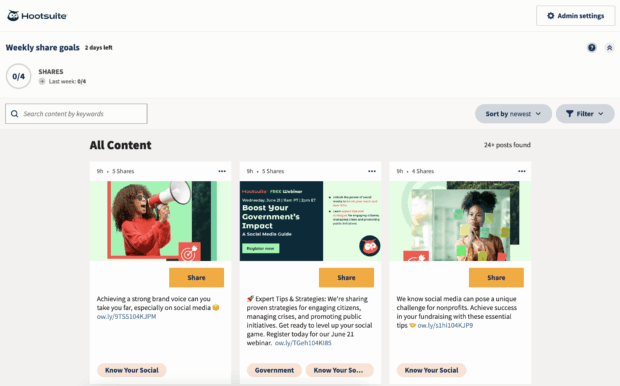
Hootsuite Amplify is an employee advocacy tool that allows you to create a library of pre-approved brand content. Employees can customize the posts and share them with a couple of clicks.
Diversity, equity, and accessibility guidelines
Your social media policy should also reflect your organization’s commitment to diversity, equity, and inclusion. Include guidance on using inclusive language, avoiding stereotypes, and ensuring visual content meets accessibility standards (e.g., alt text for images, captions for videos).
This helps protect your brand reputation, widens your audience reach, and aligns your online presence with organizational values.
For example, the UK Government Communication Service (GCS) advises communicators to build accessibility into every stage of social media planning — including providing alt text, captions, and color contrast checks — and to consider the needs of audiences with diverse cognitive, visual, hearing, or motor needs.
Escalation paths and a “pause rule”
Employees need to know what to do (and what not to do) when there are tricky things happening with your brand. Or when they encounter negative content about your brand on social channels.
“A lot of policies miss explaining what employees shouldn’t post (even on personal accounts) during high-stakes situations like product recalls, layoffs, or PR crises,” Riswick says. “This is a great addition that protects the employee and the brand.”
There are two components here:
- Pause rule. “If there’s an ongoing internal sensitive issue, avoid commenting about it, even if it’s ‘just a personal opinion,’” Riswick says. Depending on how serious the issue is, you may wish to pause all scheduled brand social content as well. (Tip: Hootsuite allows you to pause all scheduled content with just two clicks.)
- Escalation path. “If an employee sees something concerning about the brand online, they should flag it to the social or comms team — not engage directly,” Riswick says. Make sure everyone is clear about who they need to notify. It can be helpful to link to your crisis communication plan. That way, no one has to go hunting for documentation at a stressful time.
Overview of relevant legal or compliance requirements
Details will vary from country to country, or even state to state. The requirements are much more onerous for organizations in the regulated industries. Be sure to consult your legal counsel for this section.
At a minimum, your policy might touch on the following:
- How to comply with copyright law and respect intellectual property on social media — especially for third-party content.
- How to handle customer information and other private data.
- Restrictions or disclaimers required for testimonials, influencer content, or marketing claims.
- Confidentiality regarding your organization’s internal information.
“Many policies leave out disclaimers, but all policies should specify that personal opinions be clearly identified,” says Martin Gasparian, Attorney and Owner, Maison Law.
“Employees who post on their personal accounts about company products or services should also disclose their relationship with the company,” Gasparian continues. “There are regulations governing endorsement; failure on their part to be fully transparent can lead to fines and reputational damage. Often, this will be labeled as deceptive marketing tactics, regardless of the intent.”
Want to put some automated guardrails in place? Proofpoint compliance software integrates with Hootsuite.
![Screenshot of a Hootsuite post composer for ‘PDP Test Company 2’ on LinkedIn. The text reads, ‘Check out our new training video, it’s [redacted]!’ Below, a Proofpoint compliance warning states ‘Your post is not compliant’ and flags ‘Strong Profanity’ with the offending word redacted.](https://blog.hootsuite.com/wp-content/uploads/2025/08/Proofpoint-flag.png)
It checks all your social posts for compliance issues before you publish. You can customize the controls based on industry regulations, brand style, or your social media policy.
AI guidelines
AI now touches almost every part of social media operations — from content creation to moderation — which means it’s also a growing source of brand risk.
For leadership, the policy’s role is to define not only which AI tools are approved, but also how outputs are reviewed, attributed, and disclosed. In regulated industries, this can be the difference between competitive advantage and compliance violation.
The vast majority of social marketers are now using AI to create, edit, and refine text. More than 40% are using AI tools to generate, edit, and refine images. Marketers in heavily regulated industries are using AI tools even more.
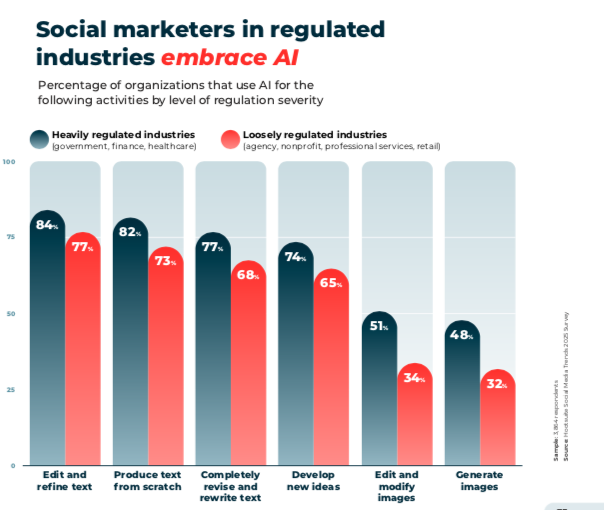
That means your social policy needs to tackle how, when, and why your teams can (and should) use AI.
“Policies now need clarity around AI disclosure and quality control,” Riswick says. “For example, is it okay for an employee to make an AI-generated picture or video that features brand elements or similar brand features? Is that aligned to the brand identity? Could that be a brand risk?”
It’s also important to clarify how employees can use your company’s brand materials to train AI. Tip: Hootsuite’s OwlyGPT gets to know your brand voice from your own social channels. You never need to upload any brand resources into third-party tools for training.
Include guidelines on which AI tools are approved for use, and what tasks they can be used for. We’ve got a whole guide to AI compliance that can help you figure this out.

How to write a policy your team will actually use
If you’re starting from scratch or updating an outdated document, our free social media policy template can help you organize these steps and ensure nothing gets missed.
Work cross-functionally
Remember: The social media policy applies to every employee—not just the social team. You need expertise from other departments and stakeholders to get all the details right to protect your organization.
Be sure to consult
- the human resources team
- any public spokespeople
- your legal team
- your product’s power users
- the marketing team
- the social team
It’s also wise to get regular employees involved in the discussion. After all, this policy affects all of them.
This doesn’t mean you need feedback from every single employee. But do get input from:
- team leads,
- union reps,
- or others who can represent groups of employees
Ask them to let you know about any ideas, questions, or concerns.
As you draft your policy, don’t get caught up in tutorials or details. The nitty-gritty will inevitably change, and fast. Focus on the big picture.
Customize for regions and business units
The overall principles of your social media policy apply to all employees. But larger companies may want to create subsections that apply to specific business units, or adapt the guidance based by region.
For example, the social media guidelines for your social team may focus more on brand style and voice. The policy for your product development team might contain a longer section on non-disclosure and trade secrets.
Train your teams
Whether it’s a revision or a brand new document, make sure everyone is aware there’s information they need to know.
If you’re launching a new update, include a list of key changes and a revision date.
We highly recommend adding your policy to your employee handbook. Encourage new hires to work through it during onboarding.
Don’t just tell employees to read the policy. Make sure they understand why it’s important. Especially employees like guides, personal trainers, and other public-facing staff. They are most likely to have customers follow them on social channels.
“I have learned firsthand that just providing the written document can make people prickly,” says Kevin Hwang, Managing Director, Ultimate Kilimanjaro. “It feels like we are encroaching on their personal space. Sharing the reasons in a friendly, nuanced approach one-on-one has helped my people to understand the whys. Keep it clear and concise, understandable about how it links to their work, and why it matters.”
Audit and update on a regular basis
Social media changes fast. Social networks and functionalities change, new social media sites emerge, and others fall. This means your social media policy needs regular review to make sure it’s keeping up.
Commit to an annual, biannual, or even quarterly review. This ensures your policy stays useful and relevant.
Pro tip for marketing leaders: Your social media policy should be a living document. Schedule a quarterly review with legal, HR, and marketing leadership to capture platform changes, regulatory updates, and emerging brand risks (like AI misuse or deepfake threats). This keeps the policy aligned with both your compliance requirements and your brand strategy.
Make sure it’s enforced
Creating a social media policy is great. But if no one’s enforcing it, why bother?
Tip: A good social listening program can help you spot posts that go against your policy before they cause problems.
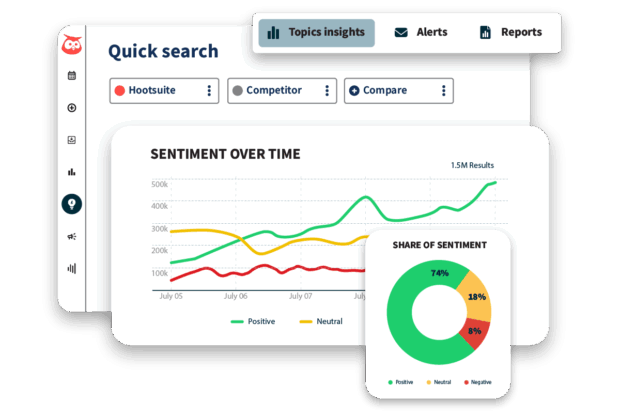
You can use Hootsuite Listening, which is built into all Hootsuite plans. It can monitor for social content that mentions your brand, along with any keywords that may indicate a policy violation. You can even set up alerts to get a notification when there’s a post you need to look at.
Here’s how this can work in practice, and why it’s important:
“A relatively new team member posted a LinkedIn update to celebrate a big executive placement,” says Jon Hill, Chairman & CEO of The Energists. “No names were mentioned. But the timing and location could have been enough for some people to guess the company.”
“Our internal social monitoring caught it quickly, and we had it taken down within the hour,” Hill said. “If that post had stayed up longer, it could have damaged a longstanding relationship or even risked legal consequences, since our work was under an NDA. Instead, the client appreciated how quickly we addressed the issue and the relationship was salvaged.”
Sometimes there’s nothing like a real-world example to get things going. Organizations in the regulated industries have the most at stake, so we’ve focused on them in selecting policies to model.
These examples don’t just show what a policy looks like — they demonstrate how different organizations translate the elements we’ve discussed into practical, enforceable guidelines.
As you review them, note how the key takeaways align with your own brand’s goals and compliance needs.
1. Canadian Bar Association
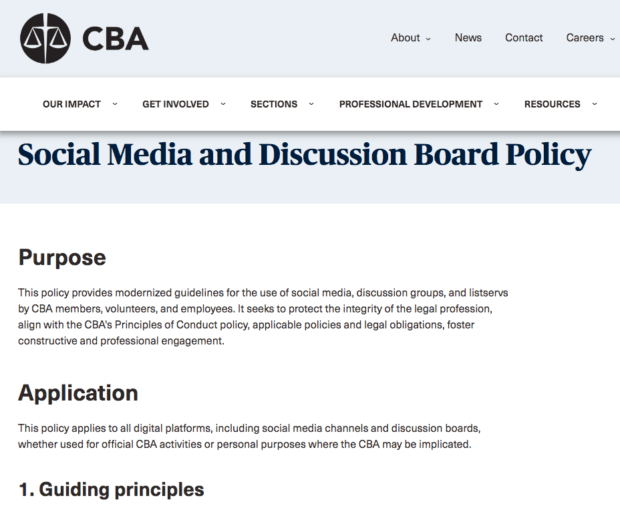
It’s no surprise that the social media policy for an association of lawyers and other legal professionals is detailed and comprehensive. It’s clear in its rules and requirements, and how they apply to relevant law. Still, the guidelines are easy to understand.
Key takeaway: “Distinguish personal opinions from official CBA positions and use disclaimers when appropriate.”
2. Tufts University
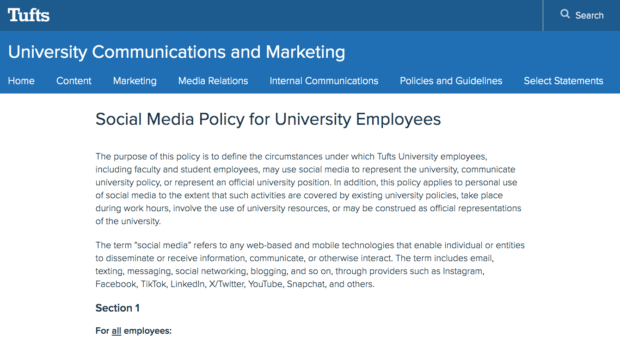
This U.S. university has a thorough social media policy. There are clear guidelines that apply to all employees. There’s also a more specific section for employees posting on official university channels.
Key takeaway: “If, from your social media post, it is clear you are a university employee, or if you mention the university, or it is reasonably clear you are referring to the university or a position taken by the university, and also express a political opinion or an opinion regarding the university’s positions or actions, you must specifically note that the opinion expressed is your personal opinion and not the university’s position.”
3. The International Center for Wellness
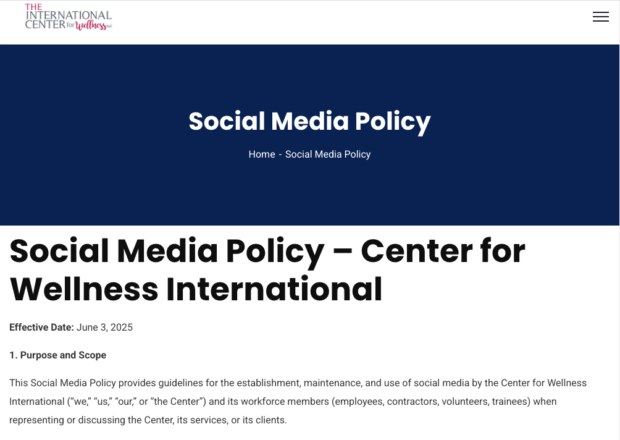
Brands in the healthcare and wellness industries have a complicated set of regulations to navigate on social media. This policy narrows in on the compliance requirements around confidentiality. It also specifies the limits on social media relationships with clients and patients.
Key takeaway: “You are bound by HIPAA and Center confidentiality policies even on your personal social media. Never disclose PHI or any confidential client information. This includes avoiding posts that could inadvertently identify a client (e.g., “Just had a tough session with a client dealing with X…”).
You now have the key elements, best practices, and real-world examples to create a social media policy that protects your brand and empowers your team. The fastest way to put this into action is to start with our free social media policy template.
It’s designed for enterprise organizations and regulated industries, with a structure that’s easy to adapt to your specific needs. Use it to capture the roles, responsibilities, and guidelines covered in this guide — and ensure nothing gets missed. Download the template here and make it your own today.
Easily manage all your company’s social media profiles using Hootsuite. From a single dashboard, you can schedule and publish posts, engage your followers, monitor relevant conversations, measure results, manage your ads, and much more.







